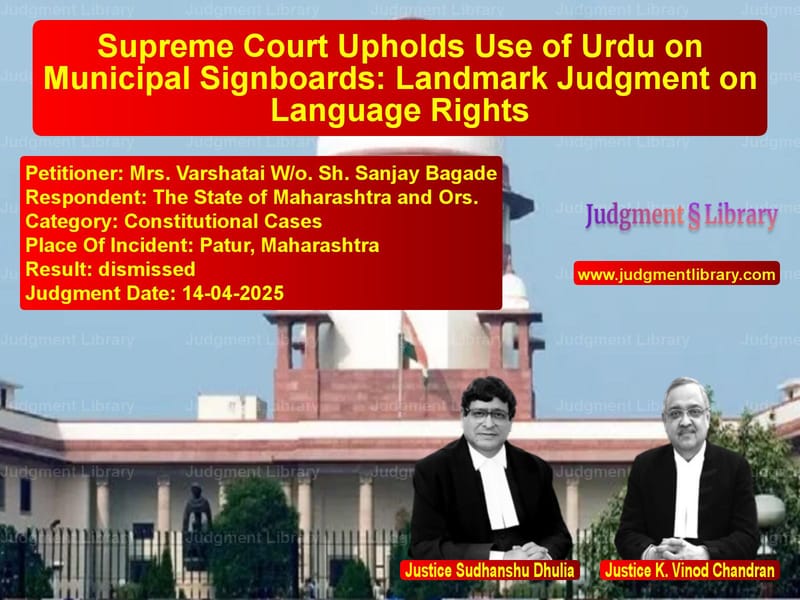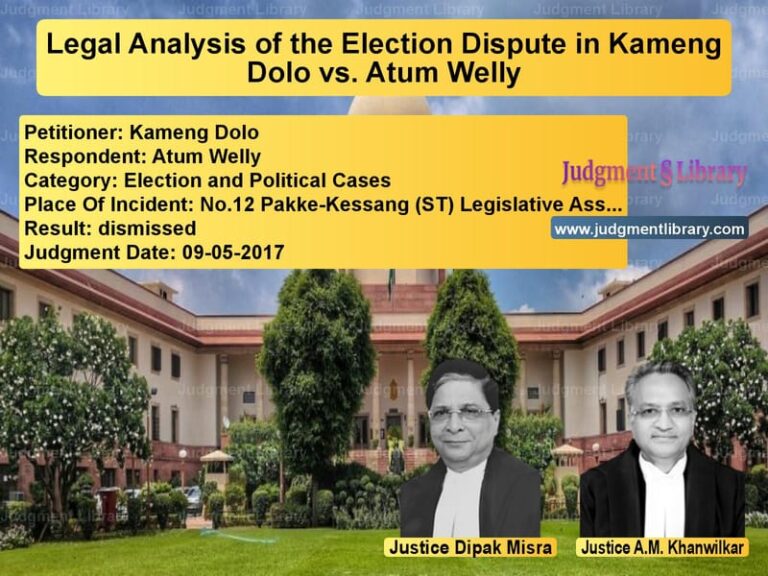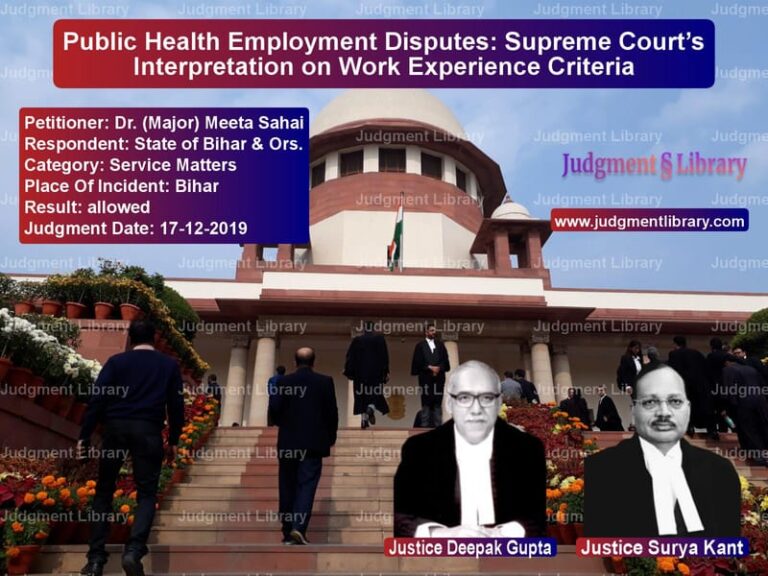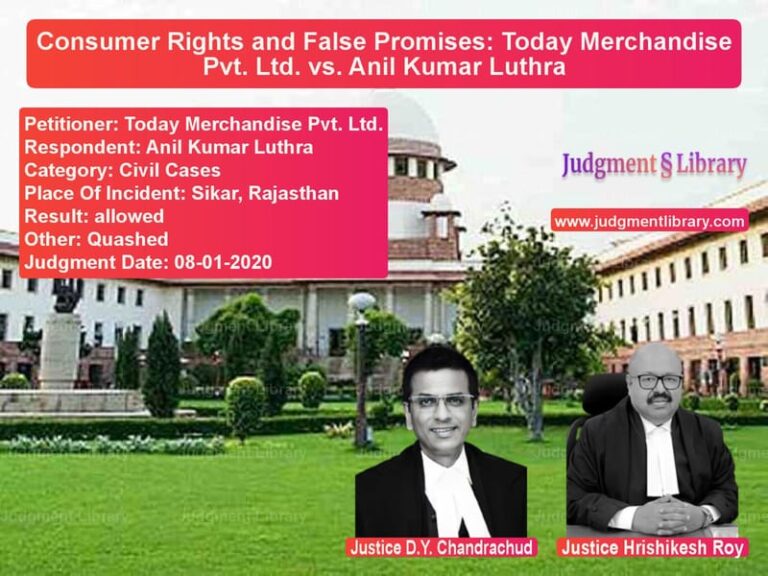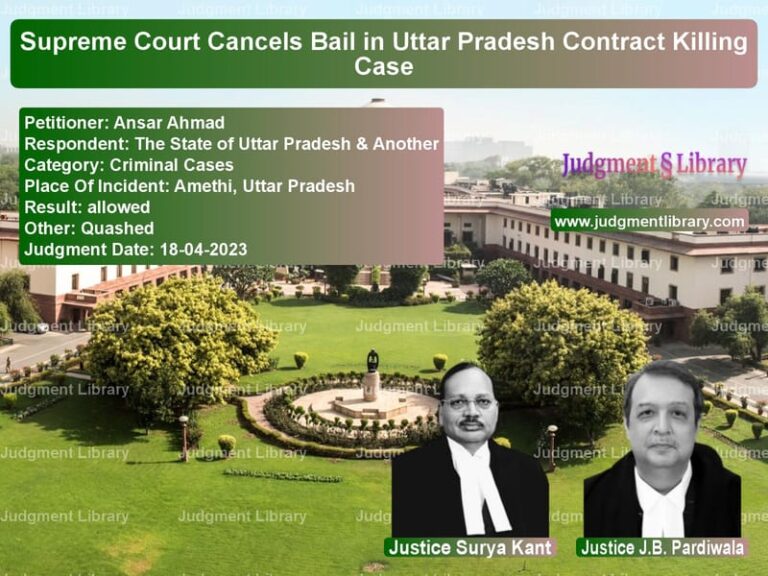Supreme Court Upholds Use of Urdu on Municipal Signboards: Landmark Judgment on Language Rights
In a landmark judgment that celebrates India’s linguistic diversity, the Supreme Court on April 15, 2025 dismissed an appeal challenging the use of Urdu language on municipal signboards in Maharashtra. The bench comprising Justices Sudhanshu Dhulia and K. Vinod Chandran delivered a comprehensive 50-page verdict in Mrs. Varshatai Bagade vs The State of Maharashtra that goes beyond the immediate dispute to examine the constitutional philosophy of language rights in India.
The case originated when the appellant, a former member of Patur Municipal Council in Akola district, objected to the display of ‘Municipal Council, Patur’ in Urdu (below Marathi) on the council’s signboard. The Municipal Council, through a majority resolution dated 14.02.2020, justified the practice citing that a significant number of council members and residents were Urdu-speaking. The appellant’s challenge went through multiple rounds of litigation before reaching the Supreme Court.
Appellant’s Arguments: The petitioner contended that:
‘Marathi is the official language of the State and all work conducted by government or government bodies, including local bodies, must be done only in Marathi.’
She relied on the Maharashtra Local Authorities (Official Languages) Act, 2022 which mandates Marathi for all official purposes.
Respondents’ Arguments: The Municipal Council members argued:
‘There is no prohibition in the Act of 2022 for any such use of a language, in addition to the official language.’
They highlighted Urdu’s constitutional status under the Eighth Schedule and its historical use in the region since 1956.
Court’s Analysis: The Supreme Court made several significant observations:
1. On Constitutional Provisions: The Court noted:
‘Marathi and Urdu occupy the same position under Schedule VIII of the Constitution of India.’
Referring to Article 345, it upheld states’ power to adopt multiple official languages, citing the Uttar Pradesh Hindi Sahitya Sammelan case where Urdu’s inclusion as second official language was validated.
2. On Nature of Language: Justice Dhulia poetically observed:
‘Language is not religion. Language does not even represent religion. Language belongs to a community, to a region, to people; and not to a religion.’
The judgment extensively traced Urdu’s origins as a product of India’s composite culture, calling it ‘the finest specimen of ganga-jamuni tahzeeb’.
3. On Linguistic Diversity: The Court noted India has 122 major languages and 234 mother tongues (2001 Census), with Urdu being the sixth most spoken scheduled language. It emphasized:
‘We must respect and rejoice in our diversity, including our many languages.’
4. On Practical Purpose: The Court held:
‘The purpose here for the use of Urdu is merely communication…This is the primary purpose of a language.’
It rejected arguments that additional language displays undermine the official language.
5. On Hindi-Urdu Relationship: The judgment contains a fascinating linguistic analysis, quoting scholars like Gyan Chand Jain and Ram Vilas Sharma to establish that:
‘Urdu and Hindi are not two separate languages; they are basically one and the same.’
6. On Historical Context: The Court traced how Hindustani (a blend of Hindi and Urdu) was nearly adopted as India’s national language pre-Independence, but partition politics changed this trajectory. It quoted Nehru’s vision that:
‘Hindi shall be enriched by borrowing the vocabulary from Urdu.’
Conclusion: The Supreme Court upheld the Bombay High Court’s view that the 2022 Act doesn’t prohibit additional language displays. It dismissed the appeal, observing:
‘The entire case of the appellant to our mind is based on a misconception of law.’
The judgment stands as a significant affirmation of India’s multilingual ethos, rejecting linguistic chauvinism while balancing official language requirements with practical communication needs.
Petitioner Name: Mrs. Varshatai W/o. Sh. Sanjay Bagade.Respondent Name: The State of Maharashtra and Ors..Judgment By: Justice Sudhanshu Dhulia, Justice K. Vinod Chandran.Place Of Incident: Patur, Maharashtra.Judgment Date: 14-04-2025.Result: dismissed.
Don’t miss out on the full details! Download the complete judgment in PDF format below and gain valuable insights instantly!
Download Judgment: mrs.-varshatai-wo.-vs-the-state-of-maharas-supreme-court-of-india-judgment-dated-14-04-2025.pdf
Directly Download Judgment: Directly download this Judgment
See all petitions in Constitution Interpretation
See all petitions in Fundamental Rights
See all petitions in Public Interest Litigation
See all petitions in Legislative Powers
See all petitions in Education Related Cases
See all petitions in Judgment by Sudhanshu Dhulia
See all petitions in Judgment by K. Vinod Chandran
See all petitions in dismissed
See all petitions in supreme court of India judgments April 2025
See all petitions in 2025 judgments
See all posts in Constitutional Cases Category
See all allowed petitions in Constitutional Cases Category
See all Dismissed petitions in Constitutional Cases Category
See all partially allowed petitions in Constitutional Cases Category

